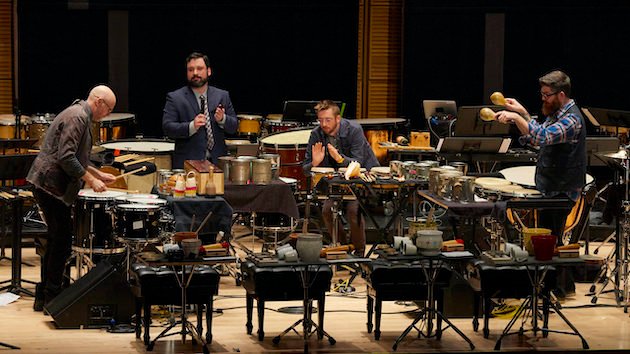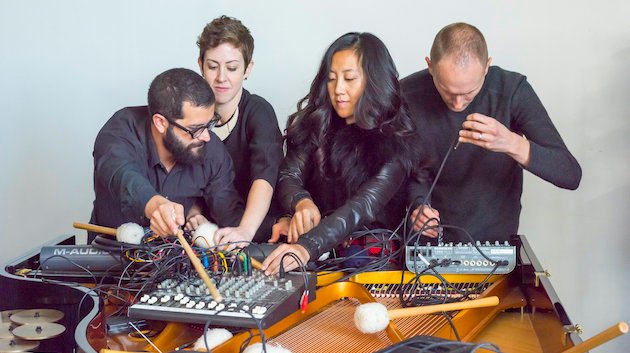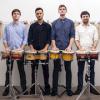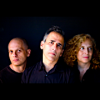
There are more percussion ensembles than there used to be.
True, that’s a low bar — there weren’t any full-time percussion-based chamber groups until recent decades in the U.S. — but now, something about the rhythm section is unquestionably helping drive contemporary art music forward.
“Why is it people are so ready for drums and rhythm making?” ponders Adam Sliwinski, a member the quartet Sō Percussion, perhaps the country’s first full-time percussion ensemble, formed in 1999. “In part, it’s because the African Diaspora has so completely permeated our lives at this point. People have grown up in a culture steeped in these influences, which go back to early jazz and slavery. Playing drums and playing rhythm harkens back to this, so now, Motown, Stevie Wonder, Prince, jazz — this has put people in a place where we’re ready to acknowledge this cultural influence. We are primed.”
OK, so listeners’ cultural senses are attuned to this, which helps explain the mass popularity of theatrical groups like the Blue Man Group or Stomp. But why are percussionists and percussion ensembles appearing more and more frequently in the contemporary classical scene? “Well, classical music is getting there in terms of welcoming experimental, new work,” said David Skidmore, an ensemble member and executive director of Third Coast Percussion, formed in 2005, which in December received its third Grammy Nomination for the new album, Hynes: Fields. (The ensemble won the Grammy Best Chamber Music/Small Ensemble Performance in 2017.)

“What I’ve seen over the past 15 years is a definite shift,” he said, pointing to the Grammys as one metric that shows that contemporary music is coming to be more widely accepted. “It’s no longer as strange as it once was for a percussion ensemble to appear on a chamber music program. The new is being embraced in a more important way than it ever has been.”
In addition to this embrace of the new, stronger education in universities and conservatories, the visceral, approachable nature of watching and listening to percussion shows and the sheer variety of sonic and timbral possibilities are all drivers in this sort of ensemble’s popularity. In 2009, critic Allan Kozinn declared in The New York Times, “If you think about it, drums are the new violins,” pointing out the newfound ubiquity of percussion on new music programs.
That trend has continued to escalate.
Percussive Proliferation
“Percussionists have always had a mandate to drive contemporary music,” said Russell Greenberg of the percussion and piano quartet Yarn / Wire. “We don’t really have anything else.” Members of all three ensembles credit the explosion of contemporary ensembles in recent decades to Bang on a Can, the ensemble and organization that revolutionized and energized the New York music scene in the 1980s and continues to blaze a path forward with tours and albums and commissions and educational programs alike.

“Once you talk about things proliferating or exploding, there’s probably some of it going on behind the scenes,” Sliwinski said, pointing to part-time groups like the Toronto-based Nexus Percussion and Percussion Group Cincinnati, Blackearth Percussion, and even the student-based Oberlin Percussion Group as forerunners that helped make a full-time ensemble seem feasible. “People think that it was always this way but it wasn’t,” he said. “We do claim some amount of credit as a proof of concept because we wrangled it and made it work.”
“It’s weird to think of Sō Percussion as an older group because we’re close to the same age, but people look up to them because they’ve been successful,” said Laura Barger, a pianist with Yarn / Wire, which formed only slightly later, in 2005. “When people have a paradigm they can look at, that helps a lot.”
The percussionists also collectively acknowledged John Cage as a foundational figure due to his explorations of noise and rhythm music. Greenberg pointed to a through line that stretches from Cage through the constructions of Steve Reich and onward, arguing that the minimalism, or pulse music, of the later 20th century in particular primed the classical music scene in the U.S. for a rhythmic uprising.
“In some ways more audience friendly music has a lot to do with this coming out of the end of the last century,” said Sō Percussion’s Jason Treuting. The visceral nature of the music is at play here as well as watching musicians move among several or dozens of different objects, tattooing different rhythms or textures, [which] can be captivating, particularly depending on the objects involved. “In some way the object-based experimentalism, it does come from the Cage era,” Treuting said. “At this point, we are all masters in holding sticks and hitting things, whether a pipe or a flower pot or an object from another culture. There’s an intense joy that comes from that.” He said that his group capitalizes on the ordinariness of the objects used in some of their pieces, as they’re fully aware that some listeners start a show thinking that they know how to hit a flowerpot. “But then we make the flowerpot sing,” he said.
“Also, it’s just a ton of fun to watch a person hit a big drum,” Greenberg said. “It’s so visceral.”
“As the pianist in the room, Russell is right, here,” Barger added. “Really, everything’s a drum.”
Skidmore also pointed to shifts in music education as a main driver of this type of ensemble’s popularity. “If you go back 50 years and look at what conservatory and college level were, things were very orchestrally focused,” he said. “Now we’re doing masterclasses all the time at great percussion programs at universities all over the country.” Members of the other ensembles concurred and said that there was a growing number of students and student groups interested in forming professional ensembles and seeking to learn about how to be successful. “If you’ve gotten far enough in the academy you probably like new music,” Skidmore added. “You’re more likely to have engaged with composers, so we’re sort of self-selected lovers of creating the new.”
Infinite Possibilities
Due to a lack of repertoire and that interest in the new, ensembles such as Sō and Third Coast and Yarn / Wire quickly began commissioning new work from friends and contacts, embracing collaboration and experimentation. They have collectively advanced the field by hundreds of new works for small percussion ensemble. “One thing is just that there’s an endless supply of instruments and an endless supply of sounds, there’s always something more to explore,” said Robert Dillon of Third Coast Percussion. “Anything in the physical realm, found objects being explored as musical instruments.” He said that Third Coast focuses on composers and music creators interested in a collaborative back and forth, and that, pre-pandemic, composers would often visit the studio multiple times to explore new sounds and combinations. “Whether you’re an academy trained composer or your knowledge came a different way, you don’t know what you don’t know about the possibilities in terms of sound,” Skidmore said. “Creativity and curiosity are the driving components of the work that excites us in our ensemble. Those aren’t about a genre but about an ethos.”
Greenberg argued that contemporary “classical” music has moved into a post-genre state altogether these days and said that Yarn/ Wire, so named for the yarn on percussion mallets and the wire in pianos, seeks music creators of all stripes who demonstrate curiosity. “Percussion lends itself to unusual music,” he said. “It makes things interesting. Or ridiculous.”
This idea of being post-genre is especially relevant for a group of instruments that trace their lineage back the dawn of music. Treuting said that the connections between improvisation and rock and hip-hop all manifest in percussion styles, which provides an easy on-ramp for listeners comfortable or interested in any of these genres. “In the percussion scene there are wonderful gateways,” he said. “Getting customers in the hall is the hardest thing, getting repeat customers is wonderful.” He said that he thinks the question of whether percussion is pushing the definition of music for audiences was settled by Cage, pointing to 4’33” as an explanation:
Any time you decide to take in sound as music it’s music: doesn’t mean it’s good or bad. You don’t really have to question whether it’s music or not, it’s more about whether you like it or not. Whenever I go to an art-music concert, I’m going to love some things, I’m going to not like some things. Some things might change my life, some I might forget before I get home. And that’s OK. That’s what we tell our audiences, that’s OK.”




